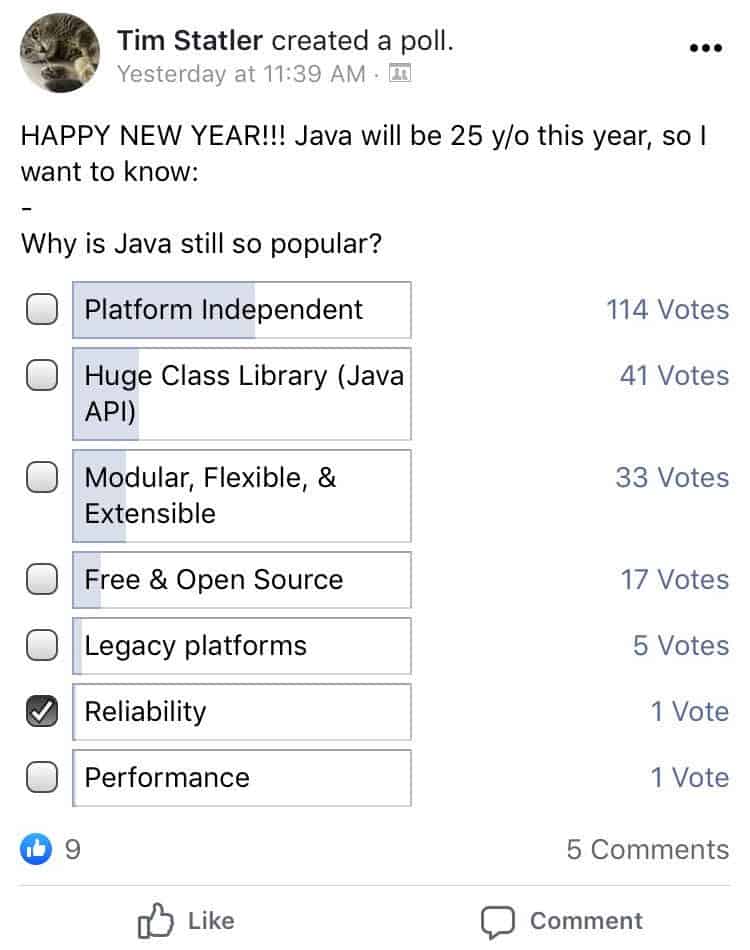As of writing this, the day is January 1st, 2020. Happy new year! Boy, how time flies. But I digress. This year, 2020, will mark the 25th birthday of the Java programming language. That said, as old as it is, Java still remains the most popular programming language in the world according to the TIOBE Index. As someone who’s not intimately familiar with all the programming languages in the world, I can’t help but wonder: Why is Java so popular?


7 Main Reasons Why Java Is So Popular
1. Java is Platform-Independent
2. Java has a massive environment and class library
3. Java is modular, flexible, and extensible
4. Java is free and open-source
5. Java supports Legacy Platforms
6. Java has performance at scale
7. Java is extremely reliable
These seven reasons are the primary reasons why Java remains so popular to this day. This is based on a poll of 212 Java programmers, as well as other independent sources which will be cited throughout this article. Keep in mind that this is somewhat opinion-based. However, these opinions are based on facts.
For example; Java is platform-independent. This is a fact. However, is it the primary reason why Java is so popular today? I’m a little skeptical. Let’s take a look at that.

Java Is Platform-Independent
As I stated earlier, this year will mark the 25th birthday of Java. Many improvements have been since then but Java has been platform-independent from the start. This was 1995, a time when no other language was platform-independent, so it was very revolutionary at the time. Right away, Java grew in popularity and continued to rise as new features were added.
In the early days of Java, this was absolutely the main reason why java was so popular. However, it also had to do with Java’s simple syntax relative to its predecessor: C++. These days, Java is not the only platform-independent language to choose from.
According to Tutoropedia platform-independent languages include; “Ruby, Lisp, Scheme, Scala, Clojure, Python, Perl, PHP, C# and the list goes on.” That said, among these languages, Java and C# are among the most popular in the world, with Java being the most popular. The list of reasons why Java is the most popular continues with its massive environment.
Java’s Massive Class Library (API)
According to JavaWorld, and API (Application Programming Interface) “…is the set of classes included with the Java Development Environment. These classes are written using the Java language and run on the JVM.” Java has a massive class library which makes it a great choice for enterprise applications. There’s virtually nothing that you can’t build with Java. This is certainly one of the main reasons why Java is still so popular after 25 years.
DevMedia says, “The availability of a large number of libraries of standardized classes is a vital reason for the popularity of Java as a standard programming language in the modern software world.”
A large number of Java developers contribute to the user-defined classes which result in a large class library. In turn, the large class library attracts more developers to further add to the class library. This is part of the reason for Java’s explosive growth in its community over the years.
Modular, Flexible, & Extensible
In a previous article I wrote titled; How Does Java Work? A Concise Guide, I explain what objects are in Java and how they interact with each other. Modules, according to InfoQ, are similar to objects in that they are parts of the whole program that interact with each other.
The concept of objects and modules are similar, but modules are on a larger scale than objects. Modules allow a program to be partitioned, which decreases coupling and makes the program easier to maintain. This is especially crucial for large-scale enterprise applications and certainly another solid reason why Java is so popular.
Java Is Free & Open-Source
OpenJDK is the free and open-source development kit which implements Java SE (Standard Edition). Oracle committed to making Java open-source in the early 2000s, which allowed for user-defined classes. Free and open-source software (FOSS) can be likened to the free market economy.
Free markets = Growth
FOSS = Growth
Not all FOSS languages experience the growth in users as Java did. That’s because it’s only one of many reasons why Java is still so popular. FOSS models don’t ensure the growth of a language. Rather, it takes back any restrictions from growth, allowing it to take on a life of its own. There are many benefits of being open-source, according to Software Freedom Day:
• Freedom to create
• Free of cost
• More options
• No vendor lock-in
• Open standards
And the list goes on and on. Seriously, check it out.
Java Supports Legacy Platforms
If you’re unfamiliar with what a legacy platform is, WhatIs explains it well: “A legacy platform, also called a legacy operating system, is an operating system (OS) no longer in widespread use, or that has been supplanted by an updated version of earlier technology. Many enterprises that use computers have legacy platforms, as well as legacy applications, that serve critical business needs.“
Here’s what this means in laymen terms: As the Java language continues to grow and evolve through different versions, it still supports the same old enterprise applications that were built with previous versions of the language. According to GeeksForGeeks, 95% of enterprise applications use Java as their main language. For this reason, Java is a great choice for applications with a long life-span and another reason why it’s still the most popular programming language in the world.
Java Is Reliable & Secure
Java wouldn’t be used to the extent that it is if it weren’t capable of producing reliable and secure applications. That said, besides Java’s lack of pointers in comparison to C, Java is not innately protected from vulnerabilities. However, Java has a security manager which allows the programmer to specify access rules, reducing potential risks. This level of reliability and security is another main reason for Java’s popularity.
Java Has Incredible Performance At Scale
Scalability is a concern of many enterprise applications. There is a reason (several really) that Java is used the majority of them. In the article, Techniques for Obtaining High Performance in Java Programs, the use of the JIT (Just-In-Time) compiler to enhance the performance of a program.
The JIT compiler works by improving performance by sacrificing Java’s platform-independent nature. The JIT compiles bytecode on the fly into the native processor. Other techniques are used to optimize performance such as executing java programs in parallel and dynamic compilation to maintain Java’s platform-independence.
Related Articles

